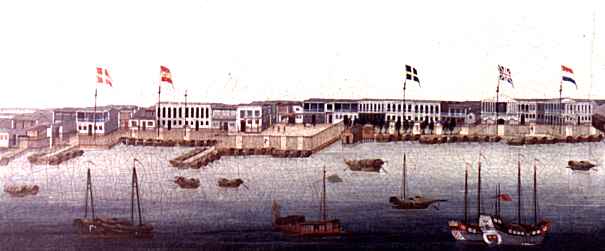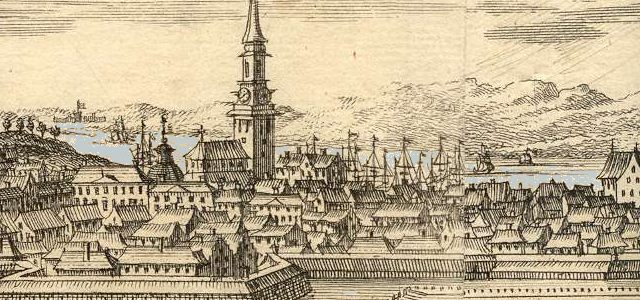

By the end of the 17th century the Dutch designed city fortress of Gothenburg was one of the most well defended in Northern Europe, surrounded by walls, bastions and a moat. This picture from 1709 was part of the 'Great Power' propaganda and I don't think that all these defense systems was really this complete or this well kept. Anyone more than I who recognizes this view fron the so called 'Deshima' porcelain patterns?
Picture detail from Dahlberg, Suecia Antiqua, Gotheborg, 1709.
Silk, spices, tea, porcelain and other exotic products of China had been eagerly sought by Europeans since Roman times. But the land route through the deserts along the "Silk Route" allowed only a trickle of Oriental products to reach the Western World. In the 16th century the sea route from the West around the Cape of Good Hope to India and China was discovered. In the centuries that followed the seafaring nations of Europe fiercely competed for control of the China Trade.
In the early 18th century, the collection of Japanese and Chinese porcelain became an obcession among the European aristocracy. Separate rooms and castles were built to display the collections. One of the most devoted were Alexander the Strong of Saxony who in the process actually were instrumental in disovering the secret of porcelain making himself.
About this time, in the early 18th century, the Swedish economy was in ruins after almost a hundred years of war with neighboring countries. Sweden needed a new beginning. Peaceful contacts with Europe and the rest of the world were intensified. The city of Gothenburg on the west coast of Sweden was ideally located for an important role. The successful English and Dutch East India companies already trading were closely studied and the decision was made to develop international trade with China.
In 1731 Henric Koenig & Co was given their first Swedish Royal Charter to peacefully trade with "all countries east of India". The most successful business was made with China, through the port city of Guangdong (Canton).
The China Trade was however a risky business. Taxes, tributes and bribes, often hard to distinguish were rife. Storms, pirates, diseases and rival traders were constant threats during the two-year round trip voyage from Europe.
Due to centuries of bad experiences the Chinese rightfully regarded all foreigners with suspicion whatever the pretext. Contacts with the "Foreign Devils" were severely restricted. Trading was allowed only in Canton under the supervision of especially appointed Chinese "Hong" merchants. Foreign merchants were initially not permitted to stay permanently in China and could only visit their warehouses during the trading season.
Once trading was finished, the cargo was loaded - porcelain in bundles, tubs and wooden boxes cushioned with rice paddy or marketable goods such as galingale, pepper, rice, sago, or tea, at the bottom for ballast, followed by chests of tea and finally the precious silks and spices.
To trade with the Chinese was difficult both due to the geographical distance as well as the cultural differences. To keep things simple the Swedes brought pure silver cash coins in the shape of minted Spanish coins. A complicating factor was that Swedish East India Company by Swedish law was forbidden to export Swedish silver coins out of Sweden. Not taking home the export profits in the first place, but making them available against documents in Spain, circumvented this. Often as much as 5 tons of minted silver coins were brought onboard in Cadiz.

When the ships arrived to China tea, porcelain, silk and spices was bought for the silver. The cargo was shipped back to Sweden to be sold at auction in Gothenburg. The business gave large profits to both the Swedish and the Chinese merchants and continued during more than 80 years. During this period the Swedish company built 38 ships - East Indiamen - and made 132 trips between Sweden and Asia - most of them to Guangdong (Canton) in China, but some also touching in India. Most went well but sometimes disaster struck - as with the East Indiaman Gotheborg in 1745. During the active period all in all eight ships were lost.
In 1813, the Swedish East India Trade was given up. Tea was no longer profitably enough because of political changes in Europe. Other companies depended on opium trade for their profits, a trade the Swedish company decided to stay out of.
In its time the SOIC was the most profitable Swedish business company ever. This trade created fortunes, industries and promoted culture, philosophy and scientific research making Sweden the world leader in several areas. Despite the risks, traders made huge profits for their companies, themselves and their countries. The Chalmers School of Technology and the Sahlgrenska Hospital are named after the company directors Chalmers and Sahlgren who donated the funding capital to these today more than ever important institutions.
Every winter one or several ships was outfitted and sent out to China or occasionally to India, to try their luck in having a safe passage, obtaining a profitable cargo and bringing this, the ship and its crew safely back to its eagerly awaiting shareholders, investors and loving families. The travels were dangerous and by far not all of the crew members came back.
Usually a journey from Sweden to China and back would take from early spring one years to late summer the next, or 17-20 months. If the unfortunate ship was forced to stay at some halfway island to wait for the trade winds of the monsoon periods to change the voyage might take almost one more year, or some 26-31 months. In general they would leave Gothenburg in January to February and touch the Staits of Java around July to August. From Java to China would take another month. To settle all busineses in Canton and take in the return cargo would take from mid-September to the end of December after which you would leave China immediately after Christmas to be back home after another 7-8 month.

City of Gothenburg in the early 17th century. Detail, as seen from the well known viewing spot at Danska Vägen. Behind the church and houses we can see ships at the Göta River. Top left is New Elfsborg Fortress inserted but it is not actually visible from this spot; it is further out.
Not even all ships made it all the way back. The most surprising and spectacular failure during the history of the Swedish East India Company occurred the 12th September 1745 when the East Indiaman Gotheborg on homecoming from China struck aground and sank just outside the Fortress of Älvsborg, with the home harbour within sight. No information remains and no documents explaining the accident have ever been found. Even a recent excavation by Anders Wästfelt that run between 1983 to 1992 failed to cast any light on this disaster that thus remains a mystery.
The Gotheborg was one of the two ships that made up the eleventh expedition of the Swedish East India Company. Here are all ships that went out from the start until 1745.
The first East Indiaman Gotheborg was built on the shipyard Terra Nova in Stockholm and had a cargo capacity of 340 läster, or 843 metric tons. She did her first voyage during the 7th expedition 1739-40 and was then auctioned to the 9th expedition for 84,000 Daler Silvermynt. The method to put a value on all assets and close the books after one expedition was by auctioning it all off to the next. In this way the true profit of the expedition could be decided. The final voyage of the Gotheborg was her third. The Gotheborg seemed to be in good condition.
To help us see what it could have looked like onboard an 18th century Swedish East Indiaman we have the diary of the Ships' priest Jacob Wallenberg who in 1769 left us his impression from a visit onboard the East Indiaman Finland. This gives us an idea of how it could possibly have looked onboard the Gotheborg a few decades earlier. If something, Gotheborg was even smaller.
Furthermost aft Wallenberg tells us, were the officials' cabins and the medicine chest, which also doubled as pulpit for the priest on Sundays. From there on, along the larboard corridor came the deckhands' hammocks, the second table where 'better food was eaten' and then a smaller table where the cadets (mid-shipmen) 'had their peas'. On the right side stood some fifty sheep and on the other side, goats, pigs and a cow from Hisingen whose calf had already 'ventured into eternity'. From the cow, they got milk. Further forward was the smoky kitchen, where the foremost hearth was for the table of the masters and in a huge copper bucket, all the rations were boiled for the crew. Immediately in front of this was the galleon, the 'bathroom' for the 150 strong crew. The starboard corridor led around three oxen, the anchor rope and 'there among the chests were the mid-shipmen and the carpenter'. Somewhere around there, the story is interrupted as the stench forces Wallenberg up on deck again. (Wallenberg, Jacob. Min son på galejan, 1769).
A persistent rumour has followed this wreck, that she was purposely put aground. This rumour has caused endless speculations but nobody has been able to - or wanted - to tell the truth. We have step by step closed in on an explanation, but it still remains to be done to tell the full history of the last trip of the East Indiaman Gotheborg.
Ever since the East Indiaman Gotheborg ran aground on 12 September 1745, it has aggravated the senses of the people of Gothenburg. The shipwreck has been discussed in all homes, maybe sometimes together with a small souvenir the sea has flushed up on the beach near the wreck site. For generations, it has been a popular Sunday pleasure to 'go wrecking' along the beach and carry home baskets of finds washed up from the huge wreck, whose solid oak frames were well into the 19th century still visible above the surface. The one thing everybody seemed to be in agreement on was that there just had to be something wrong.